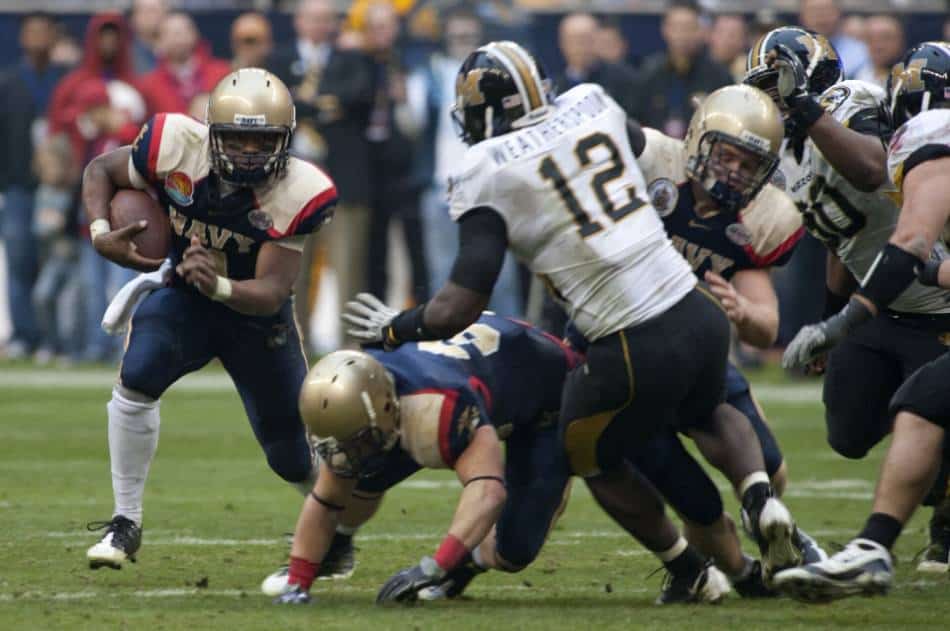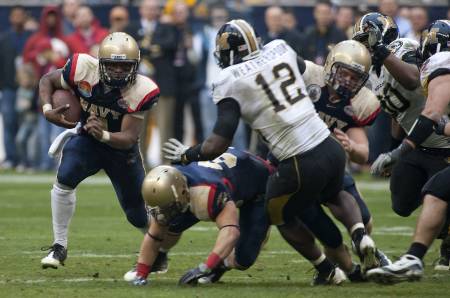
Football has many different rules, especially when it comes to blocking. There are legal and illegal blocks. One of the illegal blocks is known as a ‘chop block’.
So, what is a chop block in football?
A chop block is a type of illegal block in football that occurs when two offensive players simultaneously block a defensive player, with one offensive player blocking the upper body and the other blocking the lower body. Chop blocks are similar to cut blocks.
This article will explain what chop blocks are, why chop blocks are illegal, and how chop block penalties are assessed. Additionally, we’ll cover how chop blocks work in the NFL and how they differ from cut blocks.
What Is a Chop Block?
A chop block occurs when two offensive players block a defensive player simultaneously. One offensive player will block the lower half of the defender’s body, and the other player will block the defender above their waist.
For a chop block to occur, the two offensive players must initiate contact with the defensive player. If the defensive player initiates the contact, the block is not a chop block. It doesn’t matter which offensive player initiates the contact; the block is illegal either way.
It is also not a chop block if the two offensive players do not make intentional contact with the defensive player. For example, if the offensive players try to avoid the defensive player but they make contact with him instead.
Why Are Chop Blocks Illegal in Football?

Chop blocks are illegal at all levels of football. The main reason is that it poses a big injury risk to the player being blocked.
The biggest injuries from chop blocks are knee and ankle injuries such as MCL and ACL tears. When a player suffers an injury like this, they will likely need surgery, and it could prevent them from playing football for many months or even for the rest of their lives.
In the NFL, all chop blocks were made illegal at the start of the 2016 season. Before the rule change, there were certain situations where chop blocks were legal.
A study published in the Orthopaedic Journal of Sports Medicine compared the number of knee injuries in defensive players before and after the rule was changed. The study concluded that there was a decrease in knee injuries after all chop blocks were illegal penalties.
What Is the Penalty for a Chop Block?
When a chop block is called, there is a 15-yard penalty against the offending team. The offensive team will move 15 yards further away from their goal line.
If the defensive team commits a penalty during the same play as the offensive team commits a chop block, there is a possibility that the two penalties cancel each other out. A chop block is a 15-yard penalty, so the defense must also commit a 15-yard penalty for the penalties to offset.
However, if the defense commits a penalty worth less than 15 yards, there are a few ways that officials will enforce the two penalties depending on the league.
According to the NFL Rulebook, a major foul like a chop block takes precedence over a minor defensive penalty. Officials would disregard the defense’s penalty, and the 15-yard penalty would be assessed against the offense.
In other leagues such as the CFL, the two penalties would net each other out, and the penalty yards would be against the offense.
For example, say the offense commits a chop block during the same play the defense commits a 10-yard penalty. Both penalties would be enforced and net each other out. So, the final result of the penalty would be five yards against the offense.
A chop block penalty will not be called if the motions of a chop block occur, but the contact is incidental. The incidental contact is up to the referees.
NFL Rules on Chop Blocks
Chop blocks are illegal in the NFL, and the penalty is 15 yards. There used to be some situations where chop blocks were deemed legal before the start of the 2016 season.
The official rule for chop blocks in the NFL is as follows:
A Chop Block is a block by the offense in which one offensive player (designated as A1 for purposes of this rule) blocks a defensive player in the area of the thigh or lower while another offensive player (A2) engages that same defensive player above the waist.
In addition to the rule, the NFL outlines six specific situations where chop blocks might occur, and they are illegal.
During passing and kicking plays:
- A1 chops a defensive player while the defensive player is physically engaged above the waist by the blocking attempt of A2.
- A2 physically engages a defensive player above the waist with a blocking attempt, and A1 chops the defensive player after the contact by A2 has been broken and while A2 is still confronting the defensive player.
- A1 chops a defensive player while A2 confronts the defensive player in a pass-blocking posture but is not physically engaged with the defensive player (a “lure”).
- A1 blocks a defensive player in the area of the thigh or lower, and A2, simultaneously or immediately after the block by A1, engages the defensive player high (“reverse chop”).
During running plays:
- A1 is lined up in the backfield at the snap and subsequently chops a defensive player engaged above the waist by A2.
- A1, an offensive lineman, chops a defensive player after the defensive player has been engaged by A2 (high or low).
There were two situations when chop blocks used to be legal but are now illegal as of 2016 to help prevent injuries to players. Here was the official NFL rule prior to 2016:
A Chop Block is a legal block in the following situations on Running Plays.
(a) Offensive players A1 and A2, who are initially aligned adjacent to each another on the line of scrimmage, may chop a defensive player.
(b) Offensive players A1 and A2, who are initially aligned more than one position away from each other on the line of scrimmage, may chop a defensive player when the flow of the play is toward the block.
(c) A1 is lined up in the backfield at the snap and subsequently chops a defensive player engaged above the waist by A2, and such block occurs outside the area originally occupied by the tight end on either side.
While these used to be legal, they’re not anymore, and players and teams need to know the rule change to prevent penalties and injuries.
What Is a Cut Block in Football?

A cut block is similar to a chop block, but instead of having two offensive players attack the defensive player, it’s only one offensive player attacking the lower half of the defensive player.
Are Cut Blocks Illegal in Football?
Unlike chop blocks, cut blocks are legal in football. As long as there is only one offensive player blocking the defensive player, and the block is in the direction of play, there’s no penalty.
However, while they are legal, they can be considered a dirty play against the other team. It can be dangerous for defensive players to be blocked in this way because it presents a higher risk for injury.
Chop Block vs Cut Block
A chop block is a type of cut block, but with an additional player blocking the top half of a defender. A cut block only has one offensive player blocking the defensive player, and the block is below the defensive player’s waist.
When chop blocks occur, it doesn’t matter which offensive player initiates contact. A cut block can lead to a chop block, or a chop block can occur after a legal, upper body block.
Since a chop block and a cut block are similar, players need to be careful not to initiate a chop block if a cut block is happening. Having a second offensive player join a cut block may lead to a chop block, rendering it illegal.
Can You Block Below the Waist in the NFL?
Blocks below the waist are illegal in the NFL in almost all situations. Like chop blocks, the NFL does not allow blocks below the waist because they put players at higher risk for knee injuries.
Here is how the NFL defines a Block Below the Waist:
A Block Below the Waist is when the initial contact with any part of the blocker’s body is below the waist of an opponent, other than the runner, who has one or both feet on the ground. A blocker who makes contact above the waist and then slides below the waist has not blocked below the waist. If an opponent uses his hands to ward off a block creating contact below the waist, it is not a block below the waist.
Cut blocks are one of the only exceptions to the rule. They are currently legal in the NFL as long as the cut block is in the direction of play. Cut blocks can only be used by the offense, not the defense.
The penalty for blocking below the waist is 15 yards, and the penalty can be called against the offense or the defense.
The NFL prohibits blocks below the waist per these guidelines:
- By players of either team after a change of possession; or
- By players of the kicking team after a Free Kick, Safety Kick, Fair-Catch Kick, Punt, Field-Goal Attempt, or Try Kick; or
- By players of the receiving team during a down in which there is a Free Kick, Safety Kick, Fair-Catch Kick, Punt, Field- Goal Attempt, or Try Kick.
- By players of either team during a scrimmage down prior to a change of possession unless the contact occurs in the Tight End Box. (Note: Players are prohibited from initiating contact below the waist of an opponent outside the Tight End Box, except against a runner or a player who is attempting to catch a forward or backward pass).
The League added section D of the rule prior to the 2021 season. It makes blocks below the waist illegal outside of the tight end box, which is the area between two yards outside of the normal tackle positions to five yards on both sides of the line of scrimmage.
Even though lower body blocks are legal in the tight end box, chop blocks are still illegal in the tight end box.
